May 11, 2017
PanelPicker Opens on June 26 for the 2018 SXSW Conference

It’s already time to start thinking about SXSW 2018! We were blown away by the innovative programming submissions for 2017, so we’re excited to begin looking ahead to next season. Be part of SXSW 2018 – propose programming ideas through PanelPicker® starting Monday, June 26 through Friday, July 21.
PanelPicker is the official SXSW user-generated session submission platform. This easy, two-step online process allows the SXSW community to have a voice in what creative and thought-provoking programming is scheduled at the SXSW Conference, SXSWedu, and SXSW Gaming.
History Lesson
In 2007, the innovative online submissions tool dubbed as PanelPicker was born. SXSW values community input and involvement, so PanelPicker was developed to encourage the community to submit proposals for our daytime conference programming. The SXSW community is then able to browse submitted ideas, leave comments, and vote to help shape the SXSW Conference each March.
The SXSW Conference provides an opportunity for global professionals at every level to participate, learn, and network. With 24 tracks divided amongst Interactive, Film, Music, and Convergence, presented in a variety of session formats, each track allows attendees to explore what’s next in the worlds of entertainment, culture, and technology.
The Application Process
During the open application process, we encourage the community to upload proposals related to music, film, and digital technologies in variety of formats including panels, solo presentations, workshops, and more. When PanelPicker opens on June 26, the application process is simple: visit PanelPicker.sxsw.com, read the FAQ, and fill out the form.
All ideas received will be posted online for the PanelPicker Community Voting period – dates coming soon. Community votes makeup 30% of the final decision, plus input of the SXSW Staff (30%) and Advisory Board (40%) helps ensure that lesser-known voices have as much of a chance of being selected to speak at SXSW as individuals with large online followings. Together these percentages help determine the final programming lineup – it’s as easy as “submit, review, comment, and vote” to help shape SXSW programming.
Coming Soon
Stay tuned for more updates on PanelPicker entry, FAQs, tips, Community Meet Ups, and SXSW 2018 information. Sign up for SXSW Event Updates to receive PanelPicker notifications and follow us on Twitter, Facebook, Instagram, and SXSW News for the latest announcements, recaps, and more.
Mark your calendars for June 26 and use this advanced notice to help get those gears turning as you prepare for your PanelPicker vision quest to find that great idea.
SXSW 2017 Conference panel – Space 360: Experience NASA Missions in VR/AR/Video – Photo by Errich Petersen
Related News:
- Sign Up for SXSW Event Updates
- Watch 2017 Keynotes, Red Carpets, and Showcases on the SXSW YouTube Channel
- 2017 Grulke Prize Winners
- Vice President Joe Biden at the 2017 SXSW Conference [Video]
- A Conversation with Bob Odenkirk Moderated by Fred Armisen [Video]
The post PanelPicker Opens on June 26 for the 2018 SXSW Conference appeared first on SXSW.
Source: SxSW Film
May 11, 2017
HOW WE INCREASED OUR LEADS 78% IN ONLY 6 MONTHS
This article originally appeared on Column Five.
We’re all about content marketing. Marketing strategy, writing, designing—we have our clients covered. But sometimes we feel like a chef in a 5-star restaurant who’s tempted to reach for a Big Mac after a long shift. After putting all our heart into the work we do for others, the last thing we want to do is go home and cook up our own content, so to speak. But we know that’s not how you make shit happen in marketing.
That’s why we made a change last year. We decided to upgrade our marketing. We revamped our entire content operation, including a new strategy, new team, and new ideas. We brought in people from every department, and we got some outside perspective from niche experts when we felt like we could use the extra help. It was a lot of work, but it has paid off so far.
In only 6 months, we saw some pretty sweet results, which we’re still savoring. And since we like to help everyone get better results from their marketing efforts, we’re sharing the story—and success—of how we did it in hopes that you find something useful to apply to your own organization.
HOW WE GAVE OUR MARKETING STRATEGY A MAKEOVER
Prior to last year, we hadn’t totally neglected our own marketing, but we hadn’t always made it a priority, either. Sure, we’d kick out a newsletter when we had a big announcement. We’d post a project or article on our blog here and there. We’d run a paid campaign when we came out with an e-book. These actions brought decent results, but our marketing sprints were inconsistent and scattered. It also felt like pulling teeth to get anything created for ourselves. But worst of all, there was a lingering feeling that this wasn’t sustainable.
For a long time, it wasn’t much of an issue. We’ve been lucky to have wonderful partners and great word of mouth over the last 8 years. But our organization has also grown and our business strategy has shifted over that same time period. To achieve our goals, we realized we needed to build up our marketing operation to create a cohesive buyer’s journey that included both marketing and sales. So, we got to work.
STEP 1: THE TEAM
To start, we assembled a lean marketing team. We believe in building marketing teams based on flexible roles vs. specific positions. (Read more about that here.) This philosophy helped us do a lot with our small outfit, which included:
- Marketing Manager: Brian Wolford
- Managing Editor: Katy French
- Cofounder/CEO/Marketing Director/Janitor: Josh Ritchie
Plus supporting members:
- Creative Director: Nate Butler
- Strategic Partnerships Manager: Sara Bacon
STEP 2: THE AUDIT
Because our organization and competitive landscape had changed so much in recent years, we were prepared to rebuild our strategy from scratch. So, we went back to square one.
To get a sense of our current situation, we first debriefed to discuss our current and past efforts, as well as what did and didn’t work. We also brought our sales team into the conversation. Since we were focused on creating a cohesive buyer’s journey, the sales crew helped us determine what part of the journey marketing could and should facilitate.
This exercise gave us a much better understanding of how our teams would complement each other, as well as how our efforts would support Column Five’s short- and long-term goals. (This is especially important, as we see a lot of marketers go full-steam ahead with a strategy, without understanding the context of their work in terms of the bigger picture.)
STEP 3: THE PLAN
Based on our audit conversations, we were able to craft a cohesive plan—outlining our goal, objectives, strategies, and tactics, as well as the KPIs we’d use to track our progress.
Throughout the planning process, we prioritized actions using our existing resources that would make the biggest impact. We also focused on what we could do now vs. what we wanted to do someday. (When you’re thinking big picture, it’s easy to get caught up in “what ifs” and leave with a grand, vague, and therefore weak plan.)
As each level of planning builds on the other, we wanted to make sure that everything we did supported a single, focused goal. Inspired by our company’s vision (to help build a world where everyone can live healthy and fulfilled lives), our goal was to attract more of the work we crave.

Of course, a goal is nice, but we needed a measurable objective to support the goal.
There are many ways to attract leads, but we focused on the strategies we determined would best attract those leads—specifically content marketers. For this, we honed in on 3 main strategies.
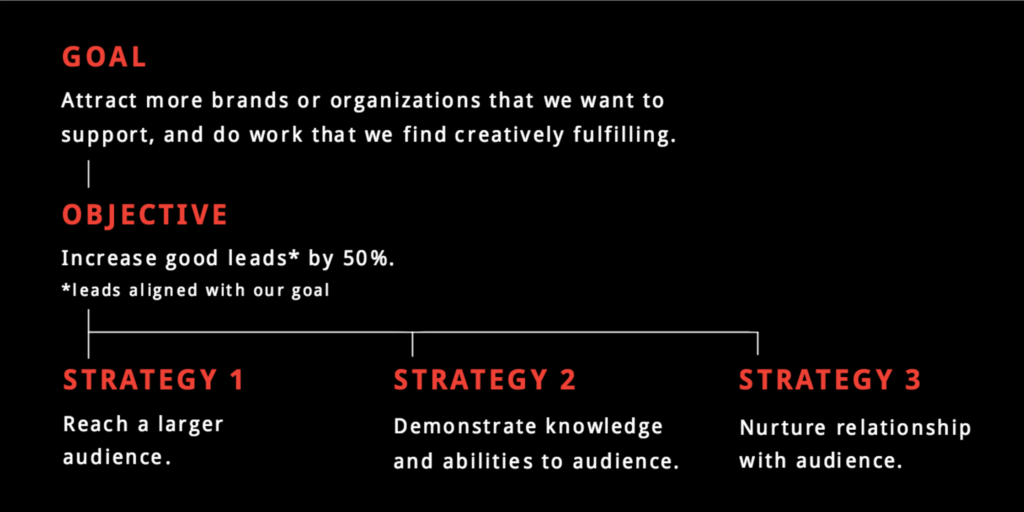
Then we got into the nitty-gritty. Again, we were focused on making the most impact with our at-hand resources, so we identified the tactics we could each tackle. Some of these were low-hanging fruit; others were a little more involved. We also determined the most useful KPIs.
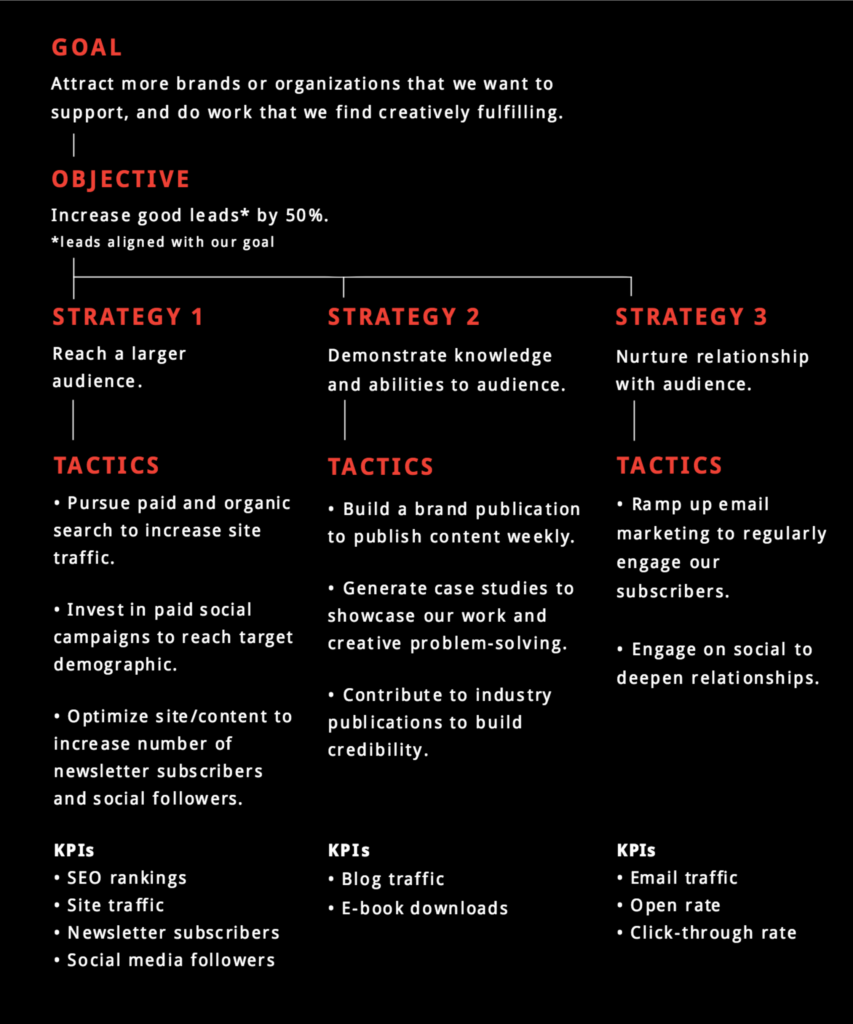
With our comprehensive plan in place, we were ready to get cracking.
STEP 4: THE EXECUTION
There was plenty of work to be done.
STRATEGY 1: REACH A LARGER AUDIENCE
TACTICS
- Pursue paid and organic SEO to increase site traffic.
- Invest in paid social campaigns to reach target demographic.
- Optimize site and content to increase number of newsletter subscribers and social followers.
PAID AND ORGANIC SEARCH
We needed more visibility in general and specifically for our core services. There are a million things you can do to improve your SEO (our heads were swimming at times), but we determined the best strategy for our particular goals and tackled the most pertinent to-dos in each area.
Paid: We had previously run paid campaigns, but this time around we directed our spending on search, display, and retargeting for keywords and phrases related to all of our services. We wanted as many as possible to have high search volume with low CPC (cost-per-click).
Organic: We had a decent amount of content on our site, but most of our pieces were several years old. To garner more traffic, we focused on:
- Keyword-specific content: We created high-value content around targeted keywords, providing an array of content for particular subjects.
- Link-building: To boost our rankings, we pursued links from pages that already ranked for our keywords and phrases. For example, we started to reach out to “best [keyword] agencies” and “top 50 [keyword] agencies” sites to confirm we were included, along with a link back to our site.
PAID SOCIAL CAMPAIGNS
We ran more targeted ads on Facebook, Twitter, and LinkedIn. In addition to boosting our content on Facebook and Instagram, we also implemented video campaigns with retargeting ads on Facebook.
SITE OPTIMIZATION
As visual communicators, design is incredibly important to us. Unfortunately, search engines don’t care about a beautiful portfolio. So, we met in the middle and tweaked our site for both search engines and user experience. This included:
- Updated messaging
- Streamlined design
- More visible CTAs and contact forms
- More content on work services landing pages
- A social plugin to make our content easier to share
- A newsletter exit popup with e-book download (only added to blog and high-traffic portfolio pages)
THE RESULTS
We started our new marketing strategy halfway through the year, in June 2016. And we immediately saw results.
SEO rankings for all of our keywords improved significantly: 10 of our service keywords now rank on page 1 of Google results.

See all the content we created for annual reports here.
In the second half of the year, traffic also jumped—79% June through December, compared to Jan through May.
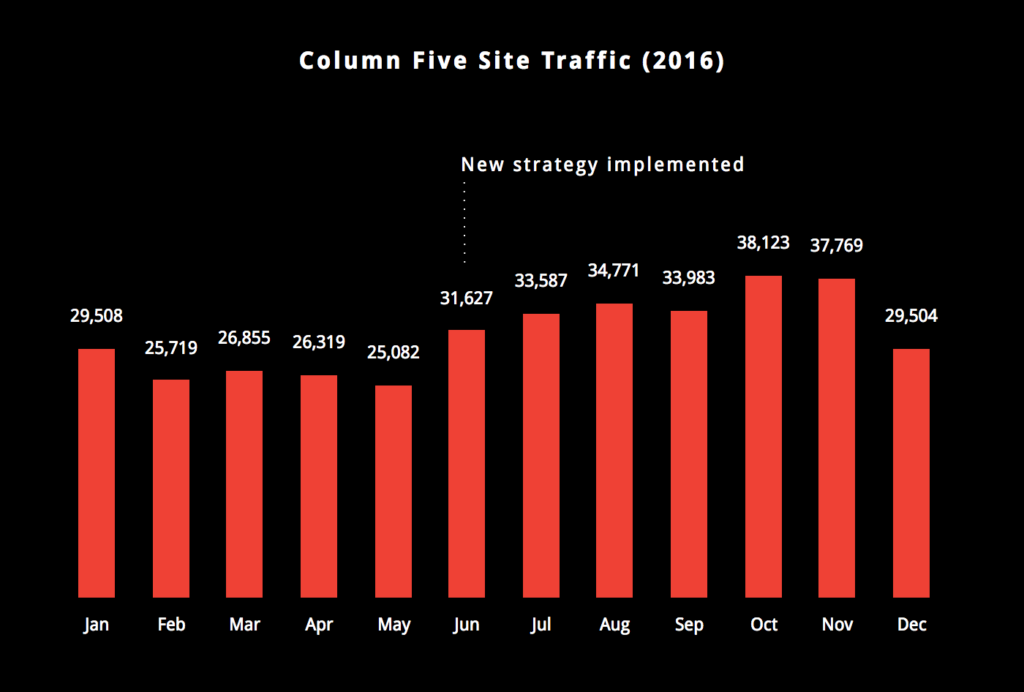
And traffic from all channels increased.
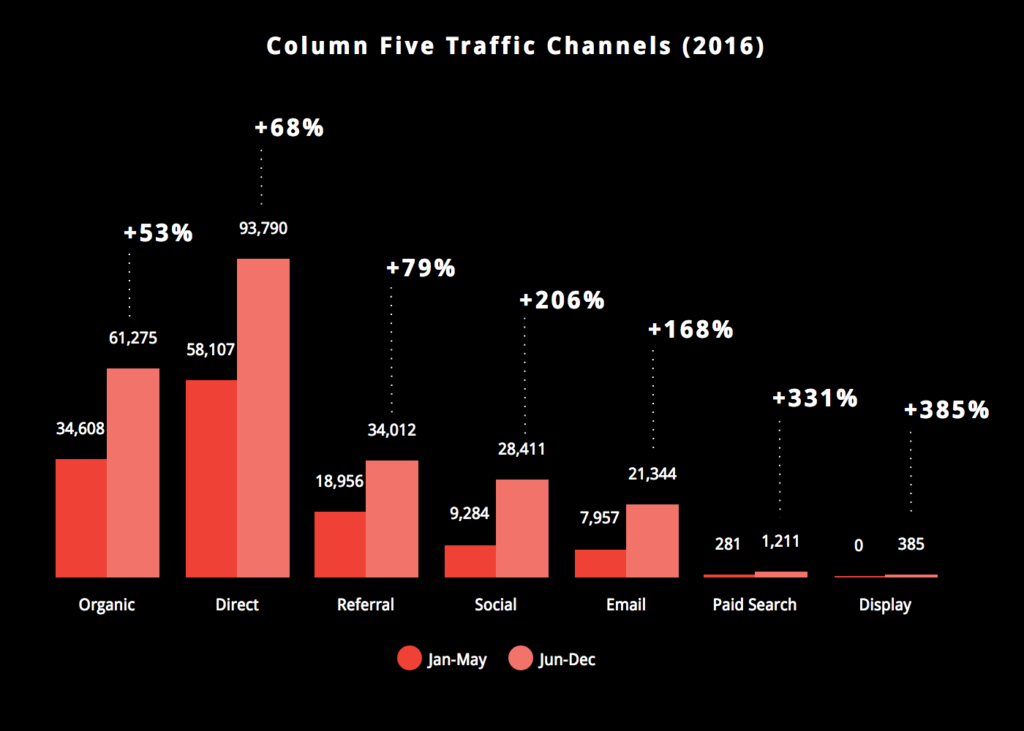
Our link-building efforts, as well as paid search and social campaigns, also paid off. While still a small percentage of total traffic, traffic from these channels jumped significantly.
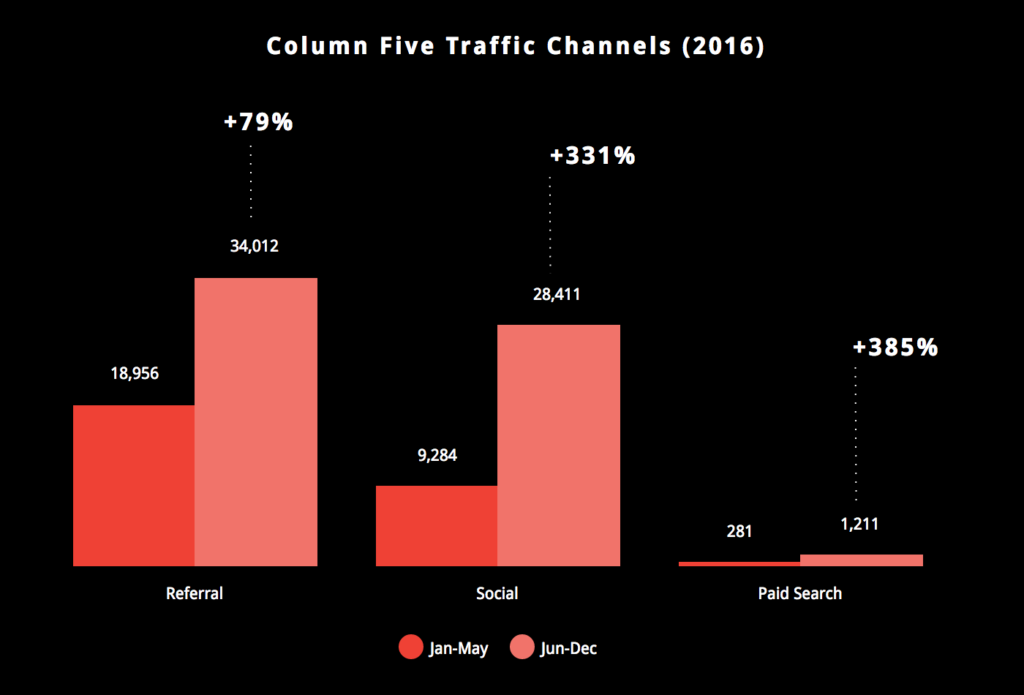
And our site optimization efforts worked. Contact form completion increased 35% thanks to our redesign. Thanks to the exit popup, newsletter signups also increased—344% in the second half of the year.
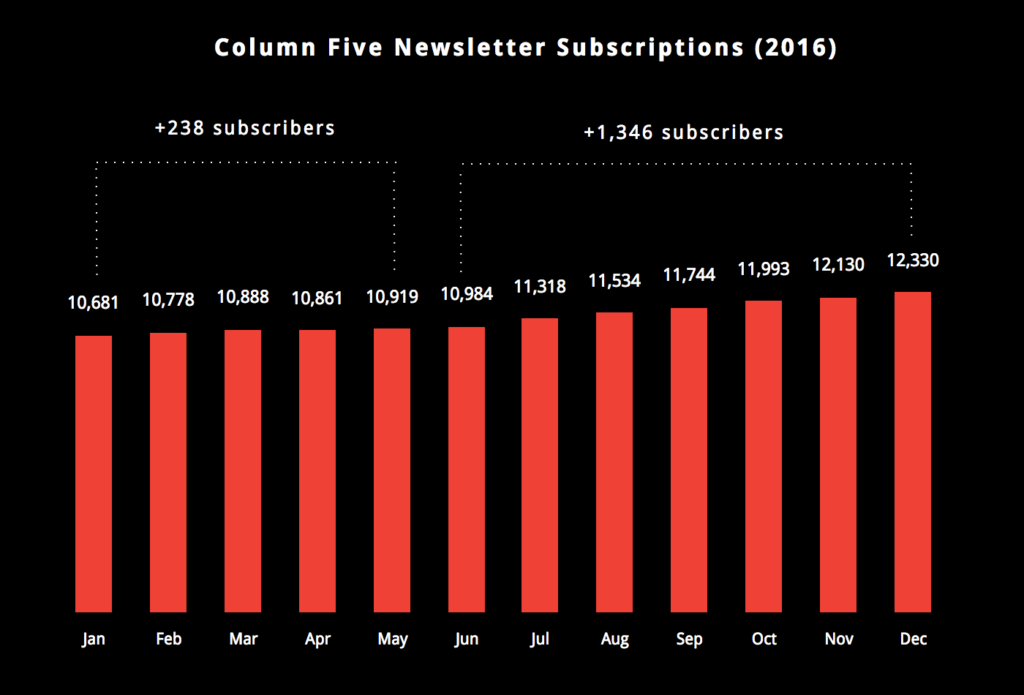
Social followers also increased 21%.
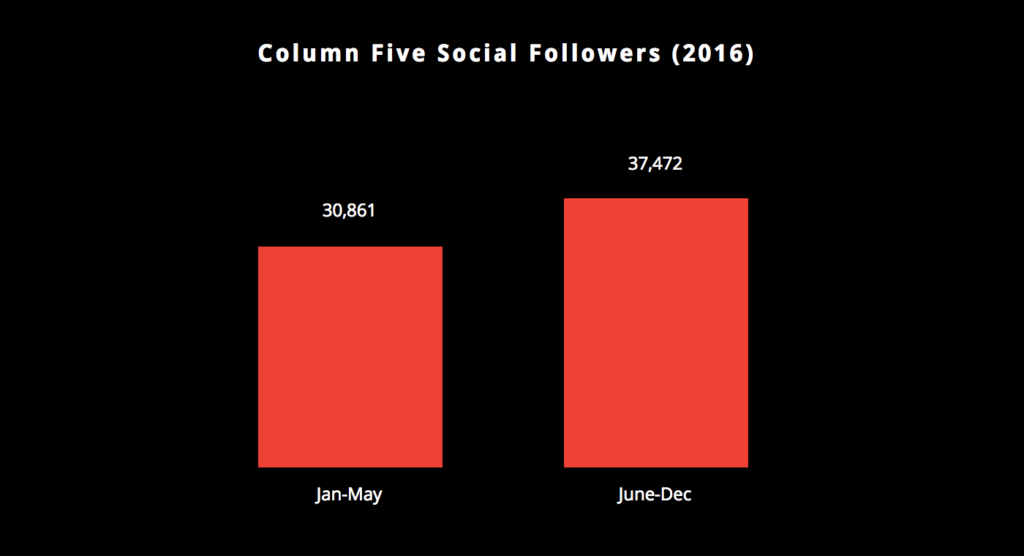
STRATEGY 2: DEMONSTRATE OUR KNOWLEDGE AND ABILITIES
Tactics
- Build a brand publication to publish content weekly.
- Generate case studies to showcase our work and creative problem-solving.
- Contribute to industry publications to build credibility.
BRAND PUBLICATION
We had always had a blog, but it often took a backseat. To really operate as a brand publisher, we revamped our editorial strategy to focus on producing valuable content for our audience—consistently. We defined valuable as:
- Useful: It would educate our audience or provide the tips, resources, and tools to do better content marketing.
- Relevant: It would address our audience’s concerns and speak to them at their level.
- Comprehensive: It would be worth their time to read.
Many brands, including us, have made the mistake of leading with brand-centric content, focusing on what you want to say and do. But the most effective content is created from an empathetic approach: focusing on what your audience needs and how you can help them. To create this content, we tweaked our editorial process.
- We created marketing personas to identify segments of our audience. (Find out how to create your own here.) Whenever we had an idea for an article, we vetted it through our personas so that we knew who each article was for and what pain point it was addressing.
- We identified our target keywords and ideated content to help us gain more SEO visibility. We also analyzed content gaps in our own archive and created additional posts to make sure we were covering our subjects from every angle.
- We stuck to a consistent publishing schedule.
- We created a distribution strategy to maximize reach, including earned and owned channels. Using CoSchedule (a super convenient editorial calendar/social-sharing tool), we set up a specific publishing schedule for every article, ensuring it would go out multiple times throughout the month on every social platform (and with different messaging).

CONTRIBUTORSHIPS
In addition to focusing on our own publishing efforts, we looked for opportunities to share our hard-earned knowledge with larger audiences. We began partnerships with major industry publications, contributing posts to HubSpot, Newscred, LinkedIn Marketing Solutions, and Forbes. We also published interviews with many movers and shakers at these publications (and other companies) to help our audience learn from their knowledge.
CASE STUDIES
We created fresh case studies and made them more visible on our site. To demonstrate our knowledge and project success, we crafted case studies as stories that centered on ROI and experimentation, including client testimonies, etc.
THE RESULTS
Our efforts paid off tremendously. From June-December, blog traffic increased 190% and accounted for 46% of site traffic (up from 28% the previous period). Our contributorships also added to the 79% jump in referral traffic site-wide.
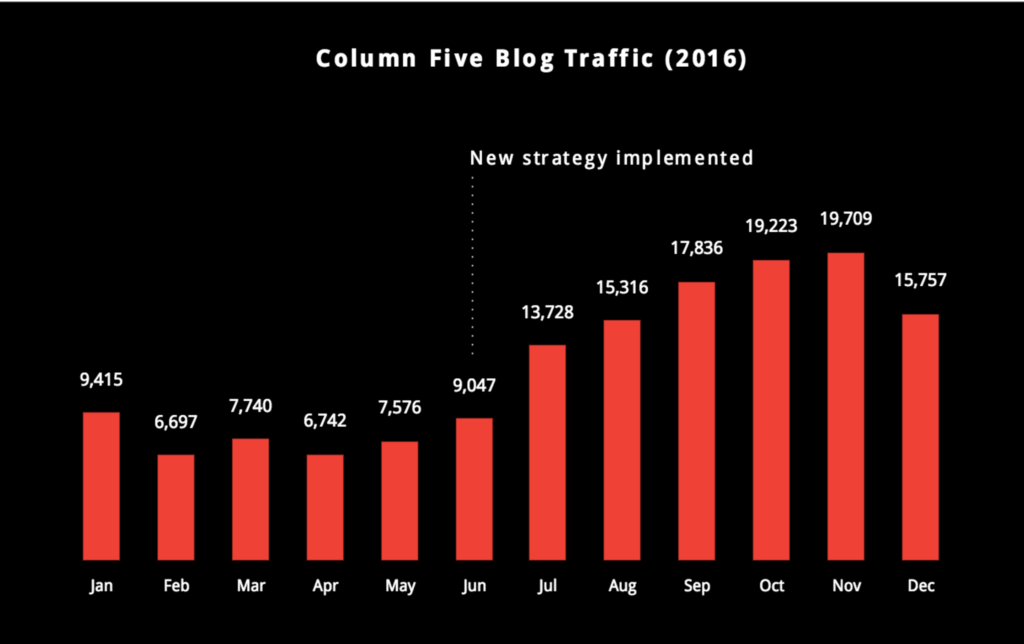
More traffic, along with the exit popup, increased e-book downloads 80%.
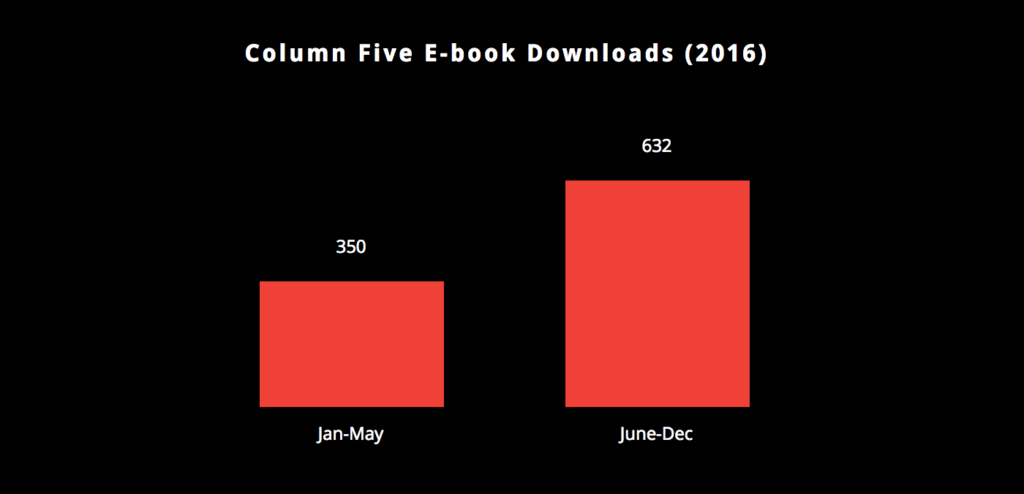
STRATEGY 3: NURTURE RELATIONSHIPS
TACTICS
- Ramp up email marketing to regularly engage our subscribers.
- Engage on social to deepen relationships.
EMAIL MARKETING
We had a decent email list, but we certainly weren’t making the most of it. (Again, we’d occasionally kick out piecemeal stuff.) Luckily, our list began to grow when we added the exit popup. In an effort to promote our content, engage that audience, and provide useful information, we increased our outreach.
We sent out a newsletter for everything we posted on the blog and tweaked how we worded those emails. Back in the day, we’d send out a long recap and link. In the interest of serving our audience, we made emails short, sweet, and to the point.
We also created drip campaigns for targeted segments and A/B tested like crazy. These campaigns first highlighted pieces of work that the target audience would be interested in, then followed up with other offers and attempts to start conversations about doing similar work together.
SOCIAL ENGAGEMENT
As a visual agency, our Instagram has always been popping, but we rarely found time to devote to our other channels: Twitter, LinkedIn, Facebook, etc. As part of our revamped social strategy, which included heavier social spending, we pushed more content out through social to maintain a steady stream and engage followers on each platform.
THE RESULTS
Our increased email marketing contributed to the 168% increase in email traffic. We didn’t hit our open rate goal of 30%, but our 22% number is on par with the creative services/agencies industry benchmark. Even better, our click-through rate averaged 14%, well above the 2.6% industry benchmark.
SO, HOW’D WE DO ON OUR GOAL?
Pretty freaking awesome. From the first half of the year to the last, we saw leads increase 78%. Compared to 2015, leads were up 51%.

WHAT WE LEARNED
It is so encouraging to see our hard work pay off—but we’ve definitely stumbled along the way and learned a hell of a lot. It taught us a lot about trying new things (and really living our core value to Experiment Often). Our biggest takeaways:
Testing changes lives: It may seem inconvenient or scary to try something different, but it will always help you learn. For example, as we experimented with email subject lines, we learned that any “How to…” or any number-based “X ways/tips/reasons…” always out-performed other variations. Additionally, we also found that we got more click-throughs by hyperlinking phrases related to the blog post instead of “click here.”
Tracking is everything: We were able to see such great results, test, and change course because we greatly improved our lead tracking (specifically by cleaning up how we labeled sources).
Refine, refine, refine: When you try something new, the fact that you’re doing it at all can feel like an accomplishment. But if it isn’t working efficiently, it’s time to experiment with your experiments. For example, we were so enthusiastic about creating keyword-targeted content that we tried to do too many posts on too many things. We soon realized it was more efficient to choose a small family of keywords and knock that content out of the park.
Your instincts can be wrong: Data is a friend for a reason. If the data is disproving your “theories,” listen to the data. For example, we were sure Twitter would be a larger source of leads, but we found our efforts there generated next to nothing. Similarly, we started out with an ambitious publishing schedule of 3 posts a week before realizing doing so actually brought our views per post down. We found 2 to be the sweet spot—and saved ourselves energy and time to focus on other important content, such as e-books.
Smaller can actually be better: Because we had a lean team, everyone took ownership of their responsibilities to make sure things got done. Larger teams can quickly stagnate in endless levels of approval or discussions over strategy.
Despite our wins, we know it’s a long road ahead. Our 2017 company mantra is to “fail better.” It’s an intimidating philosophy, but we plan to put it to the test.
We hope this post was helpful—and we hope you’ll share your own experiments in marketing, as well. For more tips on great marketing, find out how to build an agile visual content strategy, the 7 traits that will make you a better marketer, and how to create content that provides true value to your audience.
Source: Visual News
May 11, 2017
Verizon reportedly outbids AT&T for key 5G wireless spectrum
A month ago, AT&T announced it would acquire Straight Path Communications for $1.6 billion, specifically because Straight Path owns licenses to use high-frequency radio waves that will be crucial for the next generation of wireless technology. However, after that agreement, an unnamed …
Source: CW’s Flipboard Feed
May 10, 2017
What You Should Know About A Weakened Mexican Economy
During his campaign and following his election, Donald Trump has repeatedly declared his plans to break up NAFTA, build a border wall and “make Mexico pay for it”, and implement sizeable tariffs on Mexican imports. All of these measures would considerably weaken Mexico’s economy which would in turn also hurt the U.S.
These policies would not only put the American economy at risk but a weakened Mexican economy could also prove to be a security threat to the U.S. Findings in international relations have shown that political instability can result from poor economic conditions. Furthermore, this type of catalyst is likely to cause more severe political instability resulting in protests, coups, and revolutions.
This economic domino effect is evident in the Arab Springs protests that occurred across Egypt and the ongoing turmoils in Brazil and Argentina. An example that hits a bit closer to home would be how the Great Recession in 2008 lead to the tea party movement and Occupy Wall Street, both which still continue today.
The relation between a weakened economy and political instability isn’t a one way street, though. According to a 1996 study by Alberto Alesina and Roberto Perotti, when a weakened economy, particularly one that increases economic inequality, sparks political instability, the economy, in turn, is also hurt. Destabilization plants feelings of uncertainty which leads to fewer investments, reduced productivity, and governments and families become less concerned about education and training. The situation in Syria is a worst-case example of how this cycle can play out. Protests were countered with violence, which then transformed into an uncompromisable war, which caused Syria’s economy to become almost entirely annihilated, therefore making political restoration even more difficult.
Now, if we were to think about the impact this could have on Mexico, even if some of Trump’s policies somewhat make it through, there would be some serious economic and political fallout in the country. Some major concerns in Mexico that can result from economic pressure are corruption, drug trafficking, and violent crime, all of which escalate when officials and citizens are put in desperate conditions.
The citizens that would be heavily affected by Trump’s policies are Mexico’s middle class. The resulting prince increases and unemployment could lead to protests, the election of officials with extreme anti-American policies, and conflict between social groups along with the increase of crime and corruption.
So let’s just say that Trump is right and America cannot afford to be concerned about other countries other than itself. However, research repeatedly shows that instability in one country negatively impacts the surrounding region in terms of trade, defense spending, and human capital accumulation.
Analysis of 118 countries over a 25-year period has shown exactly how domestic instability affect regional instability. Although the chart below may not look like significant from an economic or financial standpoint, the correlation is compelling from a political science viewpoint.
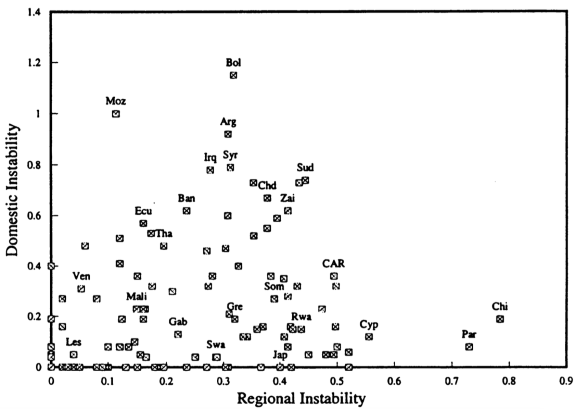
A good way to summarize the situation in Mexico and any potential consequences that may spread to the U.S. is described by FiveThirtyEight’s Andrea Jones-Rooy as so:
“[E]ven mild destabilization [in Mexico] could increase the risk of instability in the U.S. More discontent in Mexico as a result of a plummeting economy will mean more angry, armed people close to or attempting to cross U.S. borders. Weakened investment in human capital in Mexico means either more people seeking education in the U.S. or more unskilled workers crossing into the U.S. seeking a job.”
Aside from increased immigration tension from Mexico to the U.S., a more pressing concern is the potential for issues such as pollution, disease, and viral outbreaks from crossing the border.
Although you may want to think that these issues seem distant and may not affect you any time soon, Mexico’s economy is presently exhibiting signs of instability.The value of the peso has dropped, protests against Trump have already broken out, and a U.S. consular agent in Mexico was also recently attacked, all of which points to a weakening Mexican political landscape.
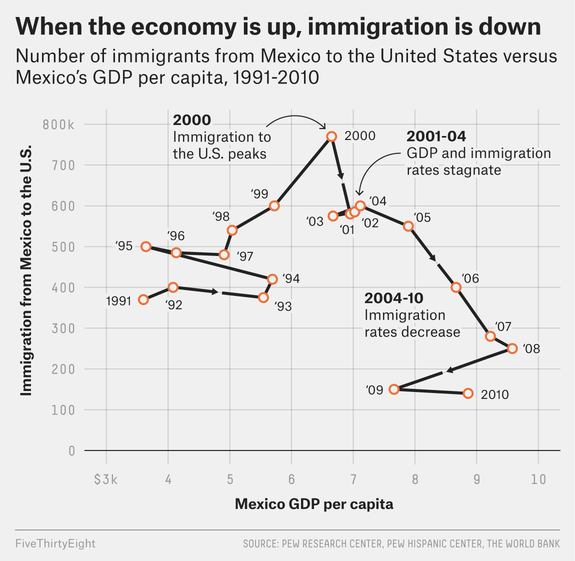
It is still possible, though, that Trump’s policies, which haven’t been set in place yet, won’t prove to be as damaging to Mexico than suggested. But based on past circumstances and empirical findings, any policies that negatively affect Mexico will in all likelihood damage U.S. politics and economics as well.
[Via: FiveThirtyEight]
Source: Visual News
May 10, 2017
Rooster Teeth Adds Guest Star William Sadler & More To ‘Day 5’ Cast — Exclusive
Rooster Teeth, the production company behind the popular digital series “Lazer Team” and “Red Vs. Blue,” announced today five new actors joining the cast of their first live-action drama, the post-apocalyptic thriller, “Day 5.”
William Sadler, who played Heywood in “The Shawshank Redemption” and more recently appeared in “Iron Man 3,” will play The Sandman, an elusive leader of a desert camp who is rumored to have found a way to sleep. He is joined by Jake Busey (“Starship Troopers”), son of Gary Busey, and new recurring cast additions Ryan Cooper (“Rough Night”), Electra Avellan (“The Son”) and Adriene Mishler (“Joe”).
READ MORE: ‘Day 5’ Review: Rooster Teeth’s Post-Apocalyptic Drama Thrills (And Kills)
“Day 5” follows a group of survivors reeling in the wake of a mysterious event that causes sleep to become deadly. With snappy dialogue and unexpected depth, the series feels like “Lost” on drugs, or “The Waking Dead” with less gratuitous violence. Season 2 continues where the waking nightmare left off, with a mysterious threat hunting down the remaining survivors, who are searching for the mysterious “Sandman’s Oasis,” where they hope to finally rest.
READ MORE: Rooster Teeth Greenlights Second Season Of Post-Apocalyptic Series ‘Day 5’ — Exclusive
“We’re excited to grow the Day 5 roster with a host of awesome new talent,” said series co-creator and showrunner Josh Flanagan. “[The new cast members] add a wealth of experience to the project, and help us bring new, fun, and occasionally insane characters to life as we expand our view of ‘The Big Sleep’ to a global scale.”
Stay on top of the latest breaking film and TV news! Sign up for our Festivals newsletter here.
Source: IndieWire Digital TV
May 9, 2017
Filmmaker In Focus Series: Filmed In Texas
Our next two featured filmmakers directed wildly entertaining independent comedies that won audience and jury accolades at the 2017 Festival. Directors Jason Headley’s Bad Idea Gone Wrong (Special Jury mention) and Noël Wells’ Mr Roosevelt (Louis Black Lone Star Award and Narrative Spotlight Audience Award) wowed audiences with their first feature length films. Headley’s short films have played on NBC’s TODAY Show, SundanceTV, Banksy’s Dismaland, the TED Conference, and more. He’s also been commissioned by Heineken, Sony, and Chrysler to write, direct, and produce original short films. Wells grew up in Texas and is a graduate of the Radio-Television-Film program at UT Austin. After graduating college, she joined a house sketch team at the Upright Citizens Brigade in LA where she was then cast as a featured player on SNL. She recently played Rachel on Master of None and starred alongside Jessica Williams in The Incredible Jessica James.
A Bad Idea Gone Wrong
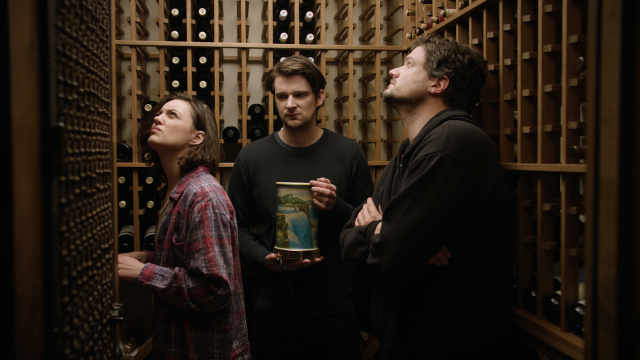
Q: Tell us a little about your film?
A: “It’s a comedy about two would-be thieves who forge a surprising relationship with with an unexpected housesitter when they accidentally trap themselves in a house they just broke into. We shot it in seventeen days in Ft. Worth, Texas between Thanksgiving and Christmas and no one got hurt. Physically, I mean. Emotionally we’re all shadows of the people we once were.”
Q: What motivated you to tell this story?
A: “I’ve written quite a few screenplays over the years, but they all required a certain investment of time and money to actually make. No spaceships or explosions, but enough characters and locations to make it add up. So I decided I was going to use the best of the storytelling craft I’d been honing and tell a really good tale with the fewest moving parts. Just take away as many barriers to production as possible. But always with an eye toward telling a story that was funny, heartfelt, and clever. That’s my trifecta as a filmmaker.”
Q:Tell us a random fact?
A: “A short of mine played at Banksy’s Dismaland. But I have not, to the best of my knowledge, ever met Banksy. I’ve made a couple of viral shorts that have garnered tens of millions of views. One of them became a book and an app which, I’m pretty sure, makes me a media mogul. But I have not, to the best of my knowledge, ever met Oprah.”
Mr. Roosevelt

Q: Tell us a little about your film?
A: “This is a coming-of-age comedy about a struggling comedian who returns to Austin after a family member falls ill. Over a weekend, she stays with her ex-boyfriend and his new girlfriend and examines her failures in her career and life.”
Q: What motivated you to tell this story?
A: “Mostly, I wanted to tell a story that took this character, Emily, on a journey of self-discovery. I’ve had the idea of a version of her since college, and it sprung out of seeing so many “millennials” and people around me struggling to find their voice, chasing their dreams, looking to belong, and grappling with insecurities, while ultimately suffering from chronic self-centeredness. But I didn’t want this to be an indictment, I wanted it to be an opportunity for a character to go through something seemingly absurd that really forces her to come to terms with her selfishness. I wanted to give her a chance to realize that success won’t ever fill her heart like a strong community does, and that the antidote to my generation’s woes is empathy, towards ourselves and our adversaries.”
Q:Tell us a random fact?
A: “I used to have pet tarantulas and squirrels and also I was on Saturday Night Live.”
Explore More Content From SXSW 2017
Get inspired by a multitude of diverse visionaries at SXSW – browse more 2017 Keynotes, Featured Sessions, Red Carpets, and Q&A’s on our YouTube Channel.
Follow us on Facebook, Twitter, Instagram, and SXSW News for the latest SXSW coverage, recaps, late-breaking announcements, and updates.
The post Filmmaker In Focus Series: Filmed In Texas appeared first on SXSW.
Source: SxSW Film
May 9, 2017
6 WAYS TO TELL YOUR BRAND STORY IN ANY PIECE OF CONTENT
This article originally appeared on Column Five.
Content marketing is one of the best ways to tell your brand story. But many marketers are confused about what that actually means. Here, we break down what a brand story is, why you need to share it, and how to communicate it through every piece of content you create.
WHAT IS YOUR BRAND STORY?
Despite the word “story,” a brand story is not a linear narrative. It isn’t even confined to the written word. It is an amalgam of your brand’s existence; it’s your essence. Your brand story is:
- Who you are: How your company came to exist, as well as your vision, mission, values, and culture.
- What you do: The product or service you provide.
- Who you do it for: The people you want to help.
- Why you do it: Your larger goal; not just what product/service you provide but how that benefits your customer (e.g., your app helps book vacations so that your customer can truly relax).
- How you do it: Visibility into your product, production, or process.
- Where you are headed: How you are evolving and working to create the best product/service for your customers.
In some ways, it can be hard to quantify a brand story because it is not one single thing, wrapped up in your website’s About page. To your audience, your brand story is both tangible and intangible, formed by the sum total of their interactions with your brand.
It’s in everything they see, read, hear, touch, experience (sometimes even taste) when they encounter your brand. It’s your website UX, the way you banter with them on Twitter, the way your customer service reps answer the phone. Your brand story is a powerful entity that functions as a conduit between you and your audience.
WHY BRAND STORY IS SO IMPORTANT
Consumers have become increasingly resistant to interruption marketing, the paradigm in which brands interrupt consumers to sell, sell, sell. Consumers don’t want to be treated as a faceless dollar bill, and they don’t want to feel preyed upon by corporate interests. But the traditional dynamic, which is inherently a one-way conversation, has made them feel this way.
Unsurprisingly, the 2014 Edelman Brandshare survey found that the majority of consumers are suspicious of brands’ intentions.
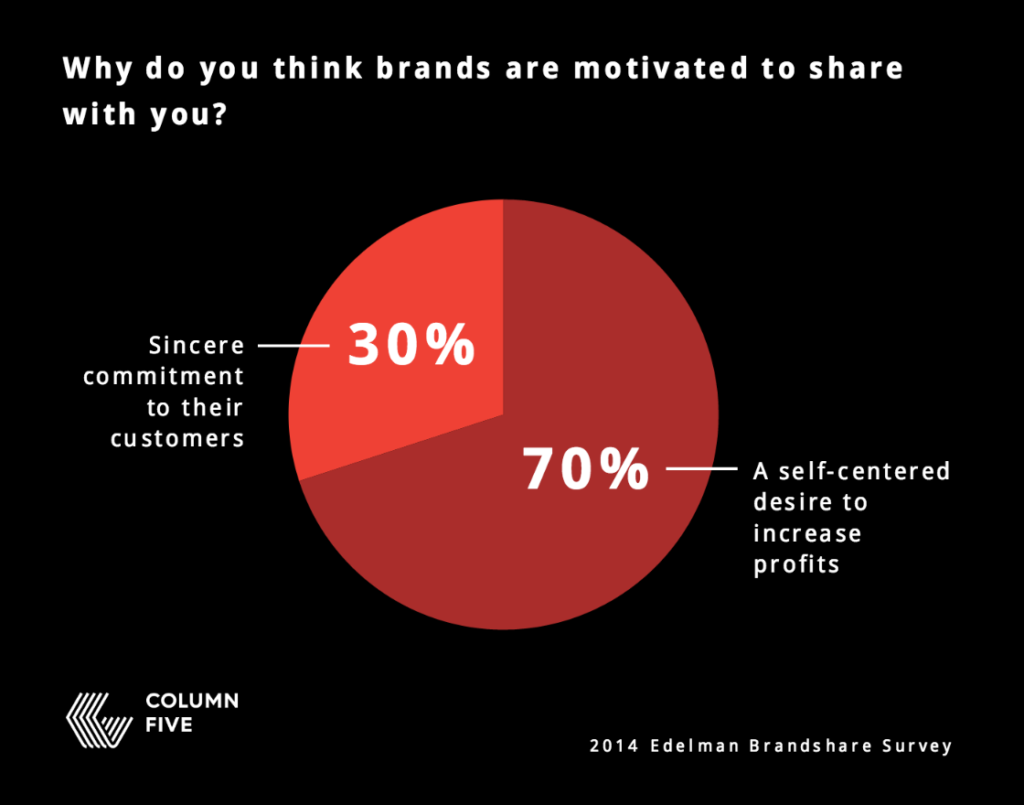
Consumers are not inherently opposed to brand communication, but they don’t want interruption. They crave engagement marketing, a dynamic in which the brand-consumer relationship is built on trust, mutual respect, and common interests. They want to connect and interact with brands, to be acknowledged as unique individuals.
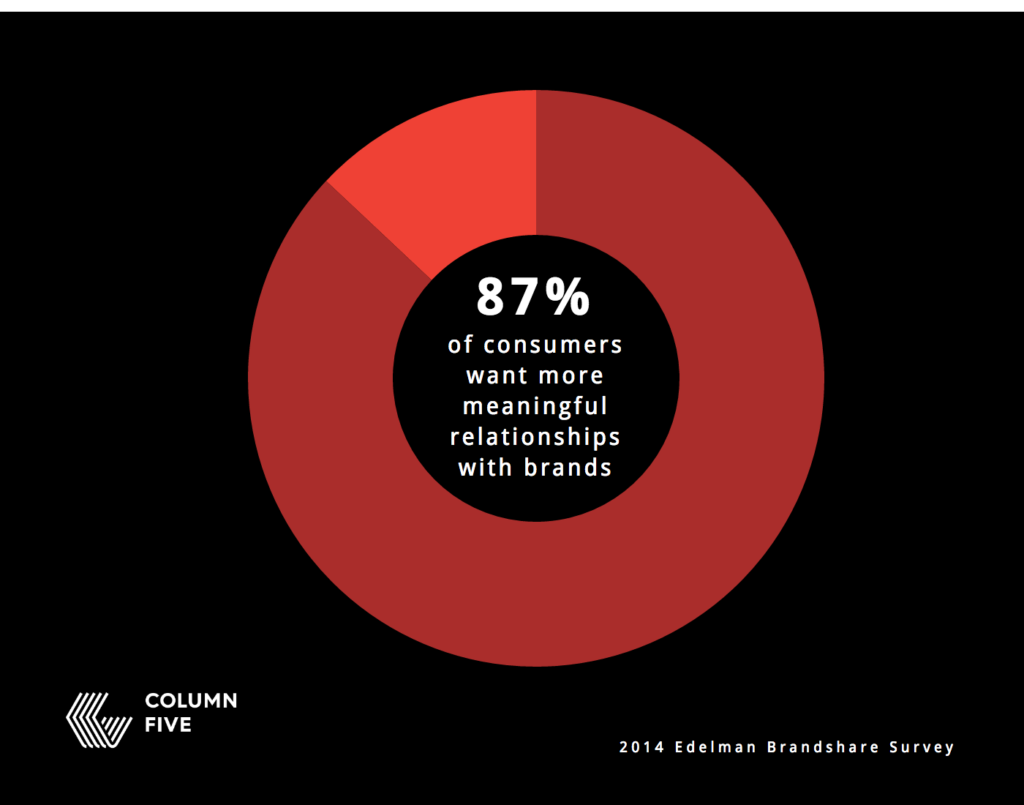
Unfortunately, although there are more ways for brands to communicate with consumers than ever, consumers largely think that brands are dropping the ball. According to Edelman, the majority feel there is an imbalance in their relationships with brands.
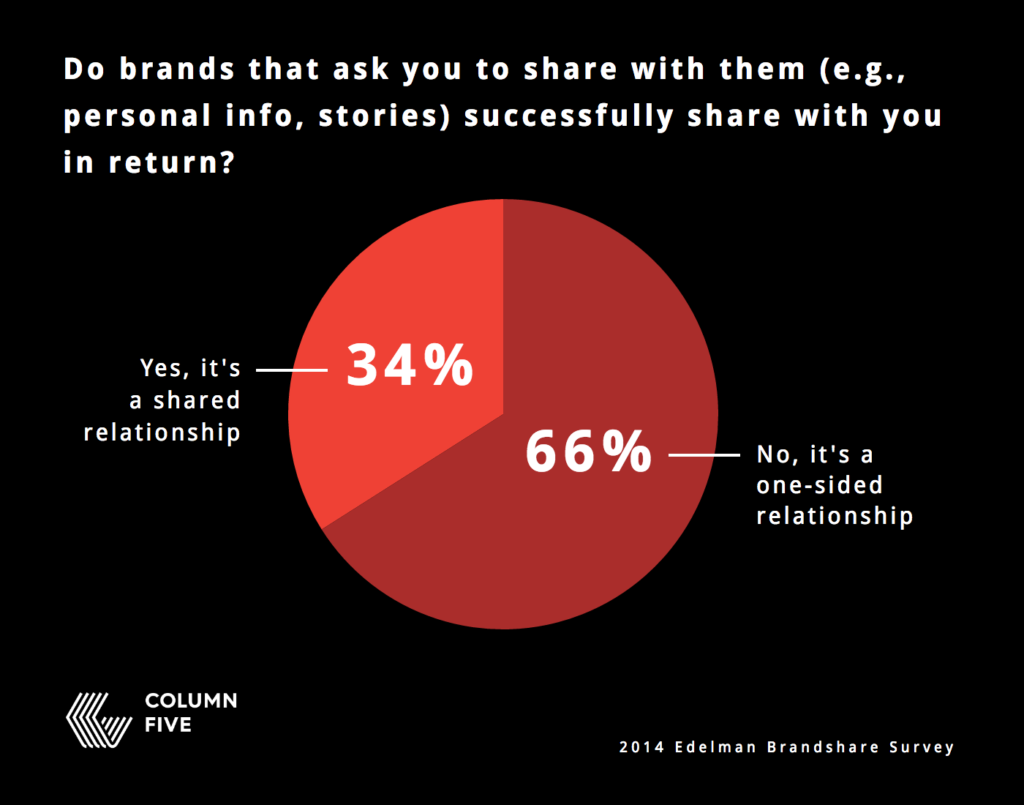
To build a better dynamic with consumers, brands need to actively cultivate relationships. This is why sharing your brand story is so vital. It’s a friendly introduction, a way to build a relationship beyond a blanket media buy.
Your brand story tells your audience who you are, why you want to help them, and why they would enjoy working with you, helping you make an authentic, genuine connection at every stage of the buyer’s journey.
Letting them behind the curtain also helps you demonstrate both confidence and vulnerability, which makes audiences more eager to trust you and accept your expertise.
Now here’s the part that many marketers hate to acknowledge: You don’t have total control over your brand story. Your story is part what you communicate and part how your consumer perceives what you communicate.
While that may be frustrating, it’s important to take control of the part of the story you can communicate it. With no brand story, your customers can write their own narrative—or worse, disregard you entirely.
COMMUNICATING YOUR BRAND STORY THROUGH CONTENT
So, how do you share your brand story? Content is one of the best tools at your disposal. Every piece of content you create supports your story, from the simplest tweet to a full-on white paper.
It’s a steady IV drip, a way to deliver your story to multiple audiences, on multiple platforms, in many formats. Storytelling content can include:
- Articles
- Case Studies
- Data visualizations
- E-books
- Explainer videos
- Infographics
- Interactive infographics
- Microcontent
- Motion Graphics
- White papers
- Video
These communication tools are also versatile and flexible. Your story isn’t static; it changes as your company grows and expands, as you bring on new team members and break into new markets. While your website may not change much, a new initiative can spawn an article, infographic, and social content to send your story far and wide.
6 WAYS TO TELL YOUR BRAND STORY
Many brands get so excited about content marketing that they push any and every idea out the door, eager to feed the content beast. This instinct is well-intentioned but destructive. The only thing worse than no content is content that is disjointed, off-brand, or inconsistent.
To ensure you’re telling the right story and setting your content up for success, follow these 6 tips.
1) CHOOSE THE RIGHT SUBJECT
Consumers want to work with brands that “get” them, that are invested in helping them solve a problem, do something better, or enhance their life in some way.
Unfortunately, too many brands are focused on what they want to create, not what their audience needs. To help you come up with the right ideas, create audience personas, which detail exactly who your audience segments are, their pain points and struggles, and how you can help address them. (Try this easy exercise to help you create personas in less than an hour.)
You can use those personas to vet all your ideas, ensuring you are giving your audience truly valuable content that demonstrates that your brand is a useful resource or helpful friend.
Example: LinkedIn Marketing Solutions is all about mobilizing marketers to grow their audience, create more effective content, and, ultimately, achieve their goals. To help their audience get better results from their marketing, we helped them create a useful e-book packed with tips, stats, and deep dives into the world of native advertising.

2) PRESENT IT IN THE RIGHT FORMAT
The most important goal for every piece of content is to communicate your brand story as efficiently and effectively as possible. Therefore, choosing the right format is vital. You might get caught up in trying to produce the flashiest, trendiest types of content, but this is a disservice to your audience.
Whether content is meant to inform, delight, or entertain, show your audience you value their time and attention by presenting it in the right package.
Example: Warby Parker is known for their tremendously creative annual reports, packed full of personality. Each year, it’s an engaging interactive report with hidden surprises, such as the opportunity for readers to create their own personal annual reports.
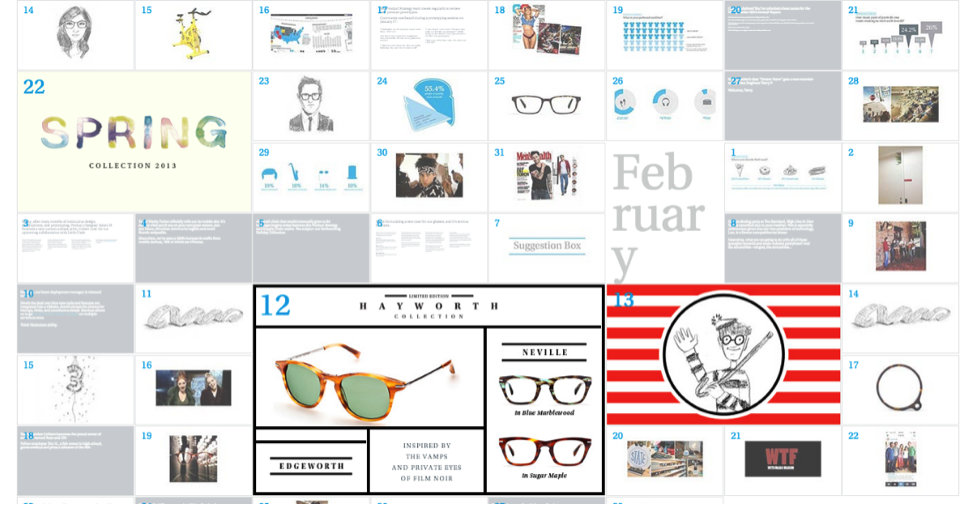
3) USE YOUR BRAND VOICE
It is way too easy to default to boring marketing speak. (See our marketing gibberish generator if you want to see what we mean.)
Your brand personality and culture are what makes your brand unique. This should be reflected in your brand story through a strong (and human!) brand voice.
Don’t know what your brand voice is? It sounds like your company conversations, Google chats, water-cooler jokes. It’s influenced by who you are and who you strive to be.
Pro tip: Once you complete a piece of content, give it a second pass for word choice and tone. These are the easiest ways to color up your content and make sure you’re speaking to your audience appropriately.
Example: This Intuit interactive uses simple, helpful, and friendly language to guide small-business owners through the process of preparing employee W-2s.
4) DESIGN WITH YOUR VISUAL LANGUAGE
Your visual language is the aesthetic experience of your brand. Everything from your logo to color palettes can affect how your content is interpreted. Whether it’s a brand video, infographic, or interactive, a consistent, on-brand visual language creates a cohesive experience.
If you don’t already, your brand should have a formal style guide. (This allows any designer to preserve brand style and integrity.) Make sure it includes specifications for:
- Logo
- Color palette
- Typography
- Iconography
- Design system (such as hierarchy)
- Photography/graphics
See our step-by-step approach to building a powerful visual language and find out what four things your brand style guide should include.
5) MAKE IT SHAREABLE
You don’t want to be the only one telling your brand story. Encourage your audience to share your story by making it easy to do so. Working social buttons, proper dimensions, SEO optimization, hashtags—consider anything you can do to foster engagement.
For more tips, find out how to optimize your blog for your publishing and how to optimize your infographics for SEO.
6) MAXIMIZE EXPOSURE
It takes a lot of work to create a great piece of content, so you should try to reach as many people as possible. Your owned channels are a great starting point, but it always helps to elevate your visibility through publishing partnerships, syndication, or cobranded work. The larger the reach, the more people will hear your brand story.
Example: We partnered with INC to create an animated infographic showcasing 3 exciting infographic trends for infographics. This gave INC a great piece of visual content and allowed us to showcase our expertise and design skills to a larger audience.

ALWAYS STRIVE TO TELL BETTER STORIES
As your brand story evolves, you will have more opportunities to connect with your audience—if you stay up-to-date on how to tell the best stories.

Going forward, continue to educate yourself, refine your brand story, and experiment with different ways to communicate your brand story. Remember: No one can tell it better than you.
Want more on telling your brand story?
- Try the Content Marketing Institute’s 10-step Hero’s Journey exercise if you have no idea what your brand story is.
- Find out how to tell better brand stories at every stage of the buyer’s journey.
- Watch this 360-degree video to learn more about how a brand is built.
Source: Visual News
May 9, 2017
Your future devices might not need wireless radios
Seemingly every connected device has at least one wireless radio in it. However, that often requires some big compromises. Those radios often chew up a lot of power, which isn’t always practical with Internet of Things gadgets that may not have much room for a battery. Disney Research may have a …
Source: CW’s Flipboard Feed
May 9, 2017
Stylish Artworks by Tanta Vorawatanakul
Stylish Artworks by Tanta Vorawatanakul
Tanta is an artist from BKK, Thailand, but currently based in San Francisco. She comes up with amazingly stylish artworks, which seem to be biographical. Casual meetings and meaningful moments beautifully illustrated.
The details on these pieces are pretty awesome, and you may even see the evolution of these in her Behance portfolio. I hope you enjoy these! Cheers. 😉
The Orangutan House
GARI GARI



That day at St. Paul’s
YOSEMITE



PauloGabriel
May 09, 2017
Source: Abduzeedo Illustration
May 8, 2017
How Much Do Amenities Impact Your Rent?
This article originally appeared on Priceonomics.
Many details about an apartment can impact monthly rent, other than the amount of space and location. For example, units that seem similar could be priced differently if one has a balcony. This price differential could be even greater in newer luxury apartments which offer things like concierge service, furnished rooftops, and fitness centers.
So what kinds of features could increase your rent? And by how much? Using thousands of apartment listings across major US cities with details including, monthly rent, number of bedrooms and bathrooms, and the presence of different amenities, we attempt to find out using data from Priceonomics customer RentHop, an apartment listing site.
We identified 10 features across the 10 largest metropolitan areas to investigate. These included:
Is the apartment furnished?
Does it allow pets?
Does it have a washer and dryer in the unit?
Does it have a common laundry room in the building?
Does it have a private outdoor space (i.e. balcony)?
Does it have a common outdoor space (i.e. shared rooftop)?
Is there a doorman?
Is there an elevator?
Is a designated parking spot included with rent?
Is there a fitness center?
Ultimately, we found that as expected, the number of bedrooms and bathrooms (highly correlated with square footage) are the biggest drivers of price. The amenities that were most associated with higher rent were having an elevator, having doorman, parking included and laundry in the unit, with each city having some variation.
Also in a rough model, designed to isolate the impact of each factor on price in NYC apartments, we found that having a doorman was the most important and increased monthly rent by about $260. The next most expensive feature was having an elevator, which increased costs by about $120.
The major drivers of rental pricing
In starting our analysis, we wanted to understand the differences in price by location. Grouping the over 450,000 records into cities, we calculated median price for each.
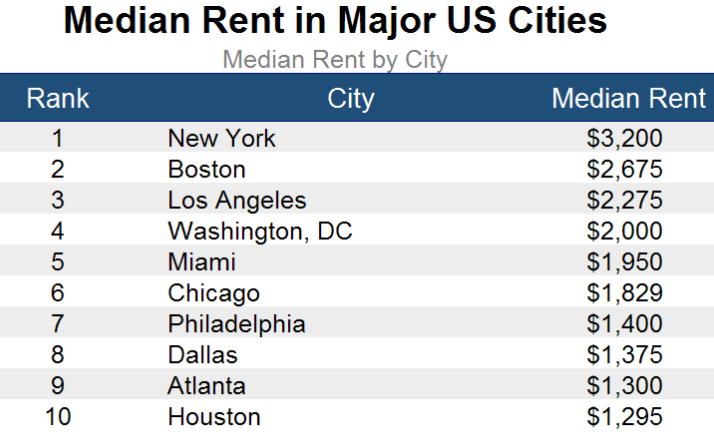
From this we can see that the most expensive city is New York, followed by the Boston area (which includes Cambridge). The least expensive city was Houston, which was cheaper by several hundred dollars.
It is important to recognize that not all apartments are easily comparable. A studio, one bedroom and two bedroom apartment are all very different, and this could impact our median price calculation. To account for this difference, we broke out our city view to compare median price by number of bedrooms.
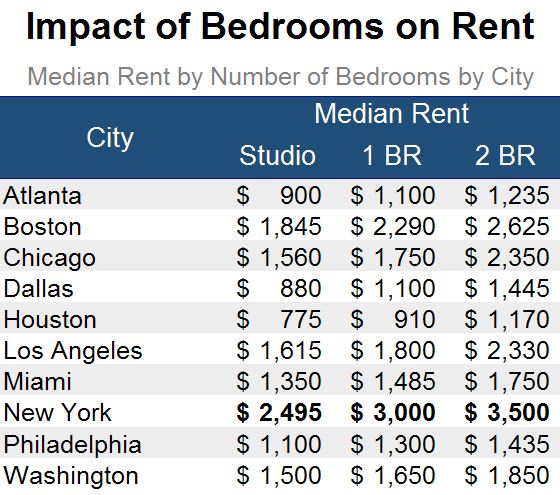
The top three most expensive cities remain the same across all categories, but on the other end of the spectrum there are some differences. While Atlanta, Houston, and Dallas has similar one-bedroom pricing, Dallas has a higher pricing for two bedrooms.
Our goal was to understand which of these factors were most related to price. It’s important to note that we did not have access to some relevant information, such as square footage, but our model is able to account somewhat for size differences using other parameters.
To start our exploration, we calculated correlation between each feature and higher monthly rent. A strong positive relationship would suggest the two are connected – and thus a specific feature may be more likely to increase your rent.
Rather than present raw numbers, we’ve color coded the results. A darker green indicates a stronger correlation with higher monthly rent.

Doorman, elevator, fitness center, laundry in unit, and parking are most correlated with price. Each market has a unique mix of what factors matter most. New York in particular has several important features including pets and fitness center as well as those mentioned previously.
It is important to call out that these factors are only more or less influential in relative terms. In absolute terms, the correlation coefficients are small and suggest only a slight relationship with higher prices.
Closer Look at New York City
To understand each factor in more detail we zoomed in on New York City, which offered the largest and most diverse set of data. We analyzed the correlation between higher price and features at a neighborhood level (focusing on the 50 neighborhoods with the most records). Understanding the neighborhoods helped us build a model for the city overall. For this analysis we focused on listings with 2 or fewer bedrooms.
Each part of New York is distinct and features can have different degrees of importance. To test this, we plotted the results of the top 10 most expensive neighborhoods to find out what was most important for higher priced apartments.

Across the board, there is a strong correlation between laundry in the unit as well as presence of a doorman on cost. Other important features appear to be allowing pets and having a fitness center.
Similarly, looking at the 10 least expensive neighborhoods, we isolated the most important features. This also provided us the benefit of comparing which are important across the range of different neighborhoods.

The same main features are important, but the degree of correlation is slightly different. Having a doorman is also a major feature but, laundry in unit is slightly less important. Relative to the more expensive locations, a fitness center is more important, while allowing pets is not correlated at all in most neighborhoods.
Finally, we created a linear regression model to predict the impact of each feature on price. From the coefficients of the linear regression equation, we can see about how much the feature impacted price. The results of the previous correlation exploration helped us to identify which features to include in our model and through a comparison of many different models, we identified the one which best predicted rent from the presence of features.
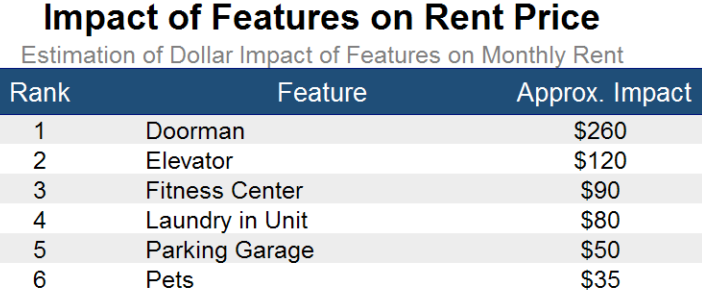
In the end, we had 9 variables in our model: 1) number of bedrooms, 2) number of bathrooms, 3) allowing pets, 4) laundry in the unit, 5) having a doorman, 6) having an elevator, 7) having a fitness center, 8) having a parking garage, and 9) a factor indicating how expensive the neighborhood is generally.
Controlling for the number of bedrooms and bathrooms, having a doorman has the greatest impact on price at about $260. This may seem like a large amount for just a doorman, but it makes sense as it is a good indicator that the building overall will be very nice and is likely in a more expensive neighborhood. The same goes for having an elevator and fitness center, which contributes roughly $120 and $90 to price, respectively. Finally having a washer and dryer inside the unit is also a major benefit. If you think you’ll spend more in $80 in quarters at the laundromat in a typical month, finding an apartment with a washer dryer may be cost effective for you.
You may have noticed there are many features that are not in our model. The other factors may have been correlated with price, but they did not have enough predictive power to improve the model beyond these four. Also as we stated earlier, this is not a perfect model. There is still a large degree of variation that our variables cannot explain. These numbers should only be regarded as a rough estimate and a way to compare relatively which matter most.
***
In the end, your price will be significantly impacted by what city you’re looking in as well as the size and location. Still, certain features do have some impact on costs and it’s important to keep these in mind when making comparisons. Being aware of the differences between listings (and how much they are worth) will help you make smarter decisions about renting.
Source: Visual News


